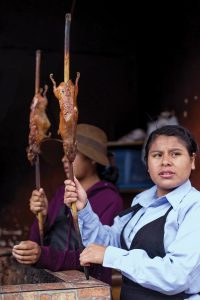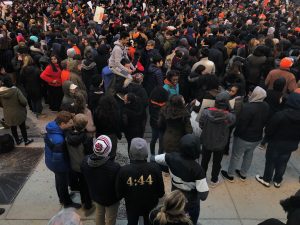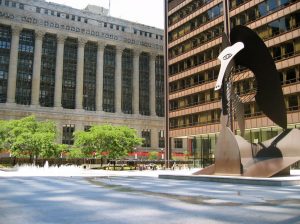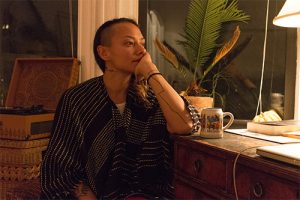Nov. 19, 2008
Story by Michelle Doellman
Jose Quintero remembers clutching his mother’s hand on the tarmac of an airport in Havana, Cuba, on August 12, 1960. Soon Quintero would be in America, away from the rising Communist regime of Fidel Castro.
Thirty-four years later, Juan Carlos Subiza, Quintero’s cousin, would make the same decision to leave his homeland, but would take a much more dangerous route. Subiza, along with 13 others, made a raft and set sail for America, praying the Cuban Coast Guard would not pick them up.
Hundreds of thousands of people have left Cuba since Castro took control by force in 1959.
Standing in his sunny kitchen in Quincy, Ill., Quintero tells of a pleasant childhood on a corner lot in Havana, the capital of Cuba. Quintero’s father had a lucrative government job and was a respected man in the sugar industry. The family lived in a compound consisting of four other homes where family members also lived.
An aunt still lives in the compound, but she says it has fallen into disrepair. Quintero has never seen pictures of where his family used to live.
Quintero was chauffeured to private school everyday, along with his two sisters. The family nanny was Celia Cruz, a well known Cuban singer, and servants were always watching over the children.
When Castro assumed power, democracy was promised but by early 1960, it was clear that was not to be the case, said Quintero. The children were not allowed outside the compound alone. Quintero’s mother even had the barber make house calls. Movies were particularly off limits, as theaters were being blown up.
“We heard gunfire every night,” said Quintero. “We would turn off the lights.”
Quintero’s mother owned a small business, but Che Guevara had begun taking money out of the banks and freezing assets. The family’s flight to the U.S. began soon after. Quintero’s father’s assets were either sold or given to Quintero’s aunt to secure visas for the family. Quintero’s father had connections in the U.S., and already had a job when the family arrived.
Quintero and his family were placed on the last flight leaving Cuba for the U.S. Before the plane left Havana airspace, the pilot was told to turn around, but he ignored the order. Quintero’s mother hid her wedding ring in her hair and the entire family had one small suitcase plus the clothes on their back.
“We thought we were going on a trip, but I think Dad knew when he left it would be the last time,” said Quintero.
The family landed at what is now Kennedy Airport in New York City, and then went on to Philadelphia, staying at a motel called The American. The children had already been enrolled in school and started on time that fall. Quintero said he felt no discrimination, but rather acceptance because the other children in school were eager to learn about these new foreign students. Despite being in the fourth or fifth grade, Quintero frequently was in the first grade class in order to learn English, which he knew none of upon arrival.
“The kids were kind of infatuated with us, like a toy,” said Quintero, laughing.
Quintero went on to college in Missouri. He has taught Spanish at the public high school in Quincy for the past 20 years and has also coached football and basketball. He and his wife Kathy have two adult children, Drew and Ashley.
Cuban heritage is not lost on Quintero’s son. Drew has a tattoo on the inside of his bicep of the outline of the Cuban island with the national flag on the inside, and recently threw a Cuba-themed party for family and friends.
While Quintero had an easy life and transition, Subiza’s story stands in sharp contrast.
Subiza had a hard life in Cuba. Although he said he always had a job, the value of Cuban money is low.
“I made about $20 a month and could not own my own house or car,” said Subiza. “How would you like to live like that?”
Subiza came to the U.S. in 1994 with his girlfriend and 11 others. They spent two days in the water before hitting land.
“It feels like you’ve been living in the dark,” said Subiza. “I was 25 when I came here and it felt like I was seeing the light for the first time.”
Everything was new to Subiza upon his arrival, especially democracy. When interviewed, Subiza was getting ready to cast his vote on Election Day in Connecticut. Part of Subiza’s journey was recorded in the documentary Balseros, which was nominated for an Academy Award.
Quintero and Subiza both became U.S. citizens. Quintero waited the standard five years before he and most of his family applied for green cards and eventually citizenship. Subiza became a citizen on November 3, 2003.
Adjustments must be made when coming to the U.S. and for Cubans, and there are many, according to Dr. Andy Gomez, assistant provost and senior fellow at the Institute for Cuban and Cuban-American Studies at the University of Miami.
“The biggest adjustment is the psychological transformation of values and attitudes,” said Gomez.
Gomez explained Cubans are not used to having liberty and freedom, so when they arrive in the U.S., they don’t know what to do with it. Also, most of the early arrivals from Cuba were whole family units who have been in the U.S. for years without any family or friends back in Cuba. Now, the newer arrivals are more often individuals who are leaving family and friends behind, said Gomez.
Gomez himself left Cuba at the age of six and a half and moved with his family to Venezuela before coming to the U.S. in 1965.
Categories:
Editor’s Choice Global Money Matters Nationwide Public Schools & Education
Tags:
cuba illinois immigration






Be First to Comment